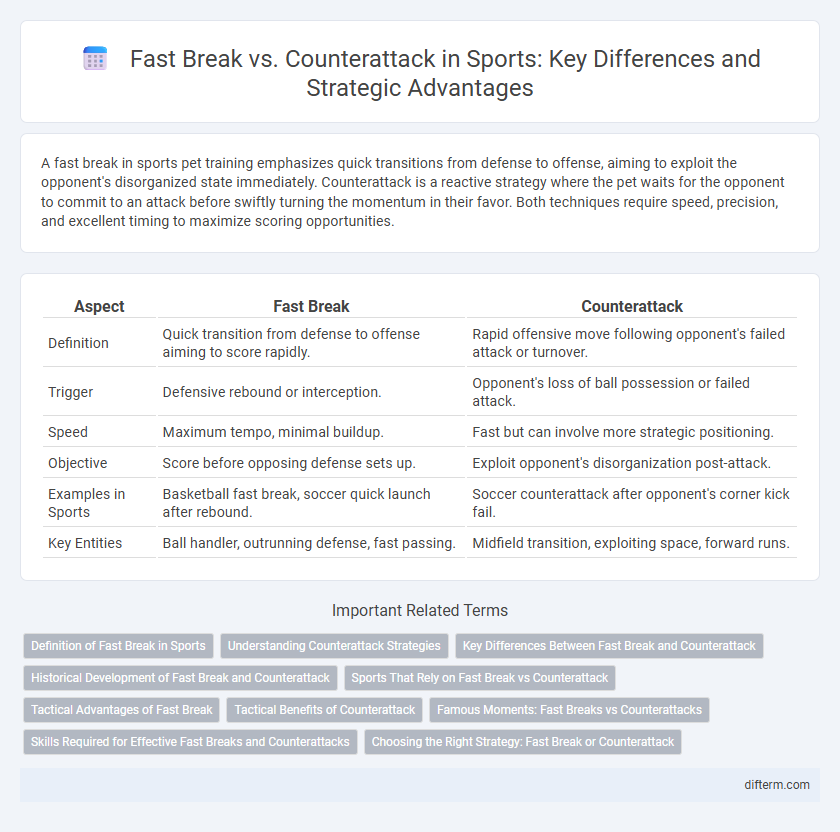A fast break in sports pet training emphasizes quick transitions from defense to offense, aiming to exploit the opponent's disorganized state immediately. Counterattack is a reactive strategy where the pet waits for the opponent to commit to an attack before swiftly turning the momentum in their favor. Both techniques require speed, precision, and excellent timing to maximize scoring opportunities.
Table of Comparison
| Aspect | Fast Break | Counterattack |
|---|---|---|
| Definition | Quick transition from defense to offense aiming to score rapidly. | Rapid offensive move following opponent's failed attack or turnover. |
| Trigger | Defensive rebound or interception. | Opponent's loss of ball possession or failed attack. |
| Speed | Maximum tempo, minimal buildup. | Fast but can involve more strategic positioning. |
| Objective | Score before opposing defense sets up. | Exploit opponent's disorganization post-attack. |
| Examples in Sports | Basketball fast break, soccer quick launch after rebound. | Soccer counterattack after opponent's corner kick fail. |
| Key Entities | Ball handler, outrunning defense, fast passing. | Midfield transition, exploiting space, forward runs. |
Definition of Fast Break in Sports
A fast break in sports is a quick offensive transition where a team rapidly moves the ball up the court or field immediately after gaining possession, aiming to score before the opposing defense can set up. This strategy emphasizes speed, precision passing, and exploiting numerical advantages to break through the defense. Fast breaks are common in basketball, soccer, and hockey, where rapid execution can lead to high-percentage scoring opportunities.
Understanding Counterattack Strategies
Counterattack strategies in sports involve quickly transitioning from defense to offense immediately after regaining possession, exploiting opponents' momentary disorganization. Unlike fast breaks that emphasize speed and numbers advantage, effective counterattacks rely on tactical positioning, precise passing, and exploiting specific weaknesses in the opponent's formation. Coaches prioritize drills that enhance players' situational awareness and rapid decision-making to maximize the impact of counterattacks during critical game moments.
Key Differences Between Fast Break and Counterattack
Fast break and counterattack differ primarily in timing and defensive transitions; a fast break occurs immediately after a defensive rebound or turnover to exploit an unsettled defense, emphasizing speed and quick ball movement. Conversely, a counterattack often develops after an opponent's attack is repelled, leveraging positional advantage and organized spacing to regain control and create scoring opportunities. Key distinctions include fast break's reliance on rapid transitions and minimal passes versus counterattack's strategic patience and structured plays.
Historical Development of Fast Break and Counterattack
The historical development of the fast break in basketball traces back to the mid-20th century when coaches like Paul Westhead popularized quick transition offense to exploit defensive lapses. In soccer, the counterattack evolved from defensive teams rapidly shifting to offense after regaining possession, with legends like Johan Cruyff demonstrating its effectiveness in the 1970s. Both strategies have transformed with advances in athletic training and tactical analysis, emphasizing speed and precision to outmaneuver opponents during transitional phases of play.
Sports That Rely on Fast Break vs Counterattack
Fast break strategies dominate basketball and handball, where quick transitions from defense to offense exploit scoring opportunities before the opposing defense sets up. Counterattacks are crucial in sports like soccer and hockey, emphasizing rapid, organized responses immediately after gaining possession to catch opponents off guard. Both tactics prioritize speed and spatial awareness but differ in execution speed and positional discipline according to the sport's pace and playing field size.
Tactical Advantages of Fast Break
Fast break tactics in sports capitalize on rapid transitions from defense to offense, exploiting opponent disorganization to create high-percentage scoring opportunities. This strategy maximizes team speed and precise passing, overwhelming defenses before they can set up, often resulting in numerical advantages and quick points. Efficient fast breaks enhance overall game tempo and pressure, disrupting opponent rhythm and increasing scoring efficiency.
Tactical Benefits of Counterattack
The tactical benefits of a counterattack in sports include exploiting the opponent's temporary disorganization immediately after their offensive play, allowing for rapid advancement and scoring opportunities. Counterattacks emphasize swift transition from defense to offense, capitalizing on fewer defenders and creating numerical superiority. This strategy enhances unpredictability and pressure, often catching opponents off guard and increasing the likelihood of successful goal attempts.
Famous Moments: Fast Breaks vs Counterattacks
Michael Jordan's iconic fast break dunk during the 1991 NBA Finals exemplifies the speed and precision of a well-executed fast break, turning defensive stops into immediate offensive points. In contrast, the 2010 FIFA World Cup saw Andres Iniesta's counterattack goal in the final, showcasing strategic patience and swift transition from defense to attack. These moments highlight the distinct impact fast breaks and counterattacks have on game momentum and outcomes across basketball and soccer.
Skills Required for Effective Fast Breaks and Counterattacks
Effective fast breaks require exceptional speed, precise ball control, and seamless team coordination to transition quickly from defense to offense. Counterattacks demand situational awareness, anticipation of opponent movements, and sharp decision-making skills to exploit temporary vulnerabilities after regaining possession. Mastery of these skills enhances a team's ability to create scoring opportunities under high-pressure conditions.
Choosing the Right Strategy: Fast Break or Counterattack
Choosing the right strategy between a fast break and a counterattack depends on team dynamics and opponent weaknesses. A fast break leverages speed and quick transitions to exploit numerical advantages, ideal for teams with fast players and high stamina. Counterattacks focus on capitalizing on opponent errors and positioning, making them effective when the opposition is vulnerable after losing possession.
fast break vs counterattack Infographic

 difterm.com
difterm.com